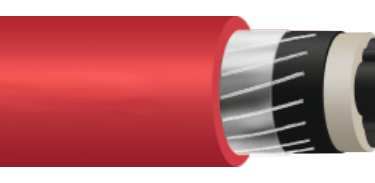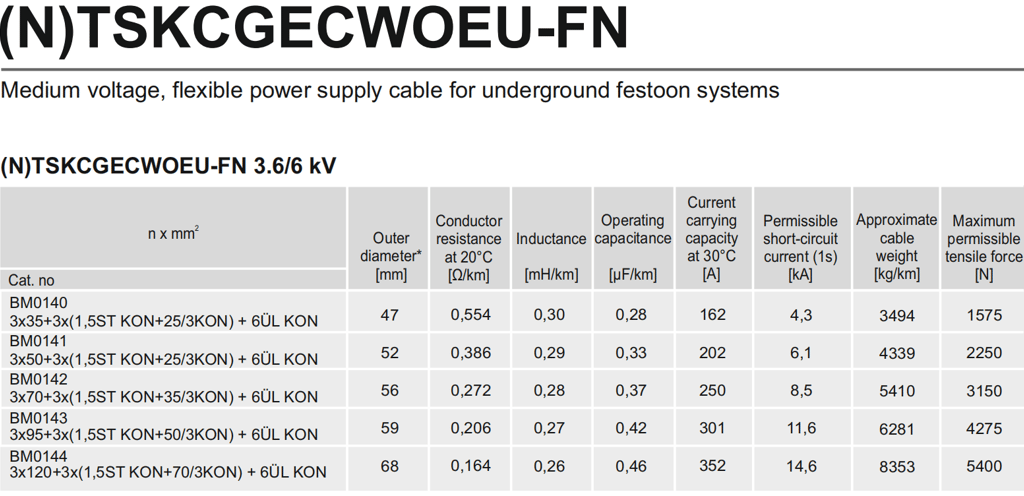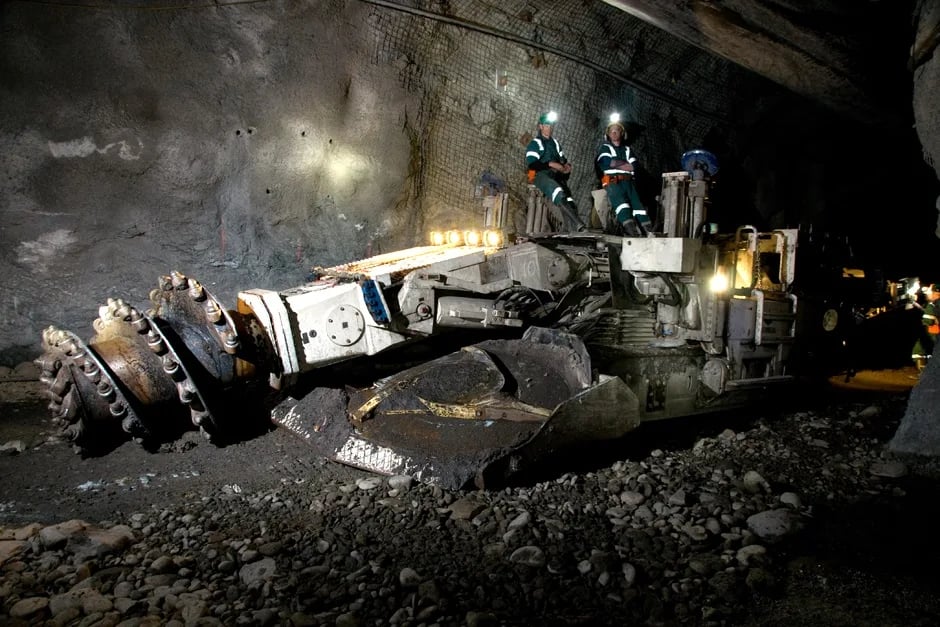📞+86 153 7530 2641 📧 hongjing.Wang@feichuncables.com

High-Performance (N)TSKCGECWOEU-FN Flexible Power Supply Cable: Medium Voltage Flexible Power Cable for Underground Festoon Systems
Discover the (N)TSKCGECWOEU-FN flexible power supply cable, a medium voltage, oil- and UV-resistant mining cable designed for underground festoon systems. Learn about its EN (CPR) compliance, thermal, mechanical, and electrical specifications, plus installation best practices and safety features.
hongjing.Wang@Feichun
8/22/202510 min read


Introduction
Overview of the (N)TSKCGECWOEU-FN Model
The (N)TSKCGECWOEU-FN represents a breakthrough in mining cable technology, specifically engineered as a flexible power supply cable for the demanding environment of underground mining operations. This medium voltage flexible power cable for underground festoon systems delivers exceptional performance where conventional cables fail, combining robust construction with advanced materials to ensure reliable power transmission in the harshest industrial conditions.
Underground mining operations present unique challenges that require specialized electrical infrastructure. The constant movement of heavy machinery, exposure to oils and chemicals, extreme temperature variations, and the need for continuous power supply in confined spaces demand cables that exceed standard industrial specifications. The (N)TSKCGECWOEU-FN addresses these challenges through innovative design and superior engineering.
Importance of Specialized Cables in Underground Mining Facilities
Mining operations rely heavily on continuous electrical power for ventilation systems, lighting, communication networks, and heavy machinery. Traditional cables often fail in mining environments due to mechanical stress from constant movement, chemical exposure from mining processes, and thermal cycling from varying operational conditions. The consequences of cable failure in underground mining can be catastrophic, leading to production shutdowns, safety hazards, and significant economic losses.
Festoon systems, which provide mobile power delivery to moving equipment along predetermined paths, require cables with exceptional flexibility, durability, and electrical reliability. The (N)TSKCGECWOEU-FN oil and UV-resistant mining cable represents the pinnacle of festoon cable technology, incorporating decades of mining industry experience into its design.
The selection of appropriate mining cables directly impacts operational efficiency, safety compliance, and long-term maintenance costs. With mining operations becoming increasingly automated and dependent on sophisticated electrical systems, the reliability of power supply cables becomes even more critical. The (N)TSKCGECWOEU-FN meets these evolving demands while providing the flexibility needed for modern mining applications.
Key Features and Benefits
Thermal Performance Excellence
The (N)TSKCGECWOEU-FN demonstrates outstanding thermal performance across extreme temperature ranges. For fixed installation applications, the cable operates reliably from -40°C to 90°C, while flexible operations are supported from -25°C to 80°C. This broad temperature range ensures consistent performance whether the cable is installed in frigid surface conditions or hot underground environments.
The maximum permissible conductor temperature of 90°C provides substantial thermal headroom for normal operations, while the short-circuit temperature rating of 250°C at the conductor ensures safety during fault conditions. These thermal characteristics are particularly important in underground mining where ambient temperatures can fluctuate significantly due to geothermal conditions, equipment heat generation, and ventilation system variations.
The thermal design incorporates advanced EPR (Ethylene Propylene Rubber) compounds that maintain their electrical and mechanical properties across the entire operating temperature range. This thermal stability translates to longer cable life, reduced maintenance requirements, and consistent electrical performance throughout the cable's service life.
Mechanical Robustness and Flexibility
The mechanical design of the (N)TSKCGECWOEU-FN centers around tinned copper conductors with class 5 fine stranding according to DIN VDE 0295. This construction provides exceptional flexibility while maintaining excellent electrical conductivity. The tinning process enhances corrosion resistance, a critical factor in mining environments where moisture and chemical exposure are common concerns.
With a maximum tensile load rating of 15 N/mm² per conductor, the cable can withstand the mechanical stresses associated with festoon system operations. The bending radius specifications according to DIN VDE 0298-3 ensure that the cable can navigate the tight turns and complex routing required in underground mining applications without compromising its electrical or mechanical integrity.
The core arrangement features three power conductors laid up with double concentric control and protective conductor elements positioned in the outer interstices. This optimized lay length design minimizes mechanical stress during flexing while maintaining consistent electrical characteristics. The spirally applied concentric conductors provide both control functionality and mechanical protection.
Environmental Resistance and Durability
Environmental resistance represents one of the most critical aspects of mining cable performance. The (N)TSKCGECWOEU-FN exhibits exceptional oil resistance according to DIN EN/IEC 60811-404, ensuring reliable operation in environments where hydraulic fluids, lubricants, and other petroleum-based products are prevalent.
UV and ozone resistance enable unrestricted outdoor use, making the cable suitable for surface installations and areas where natural or artificial UV exposure occurs. This weather resistance extends to moisture protection, ensuring that the cable maintains its electrical properties in wet mining conditions.
Fire behavior compliance with DIN EN/IEC 60332-1-2 provides additional safety assurance. The cable's flame retardant properties help prevent fire propagation, a critical safety feature in underground environments where fire suppression can be challenging and evacuation routes may be limited.
Advanced Electrical Characteristics
The electrical design of the (N)TSKCGECWOEU-FN optimizes power transmission efficiency while maintaining safety margins. With a rated voltage of 3.6/6 kV, the cable supports medium voltage applications common in mining operations. The AC test voltage specification according to DIN VDE 0250-813 ensures reliable insulation performance under both normal and fault conditions.
Conductor resistance values vary from 0.554 Ω/km for the 35mm² variant to 0.164 Ω/km for the 120mm² configuration, providing options for different power transmission requirements. The inductance and capacitance characteristics are optimized to minimize power losses and maintain power quality over extended cable runs.
Current-carrying capacities range from 162A to 352A depending on conductor size, providing substantial power transmission capability for mining equipment. The permissible short-circuit current ratings, ranging from 4.3 kA to 14.6 kA for one second, ensure safe operation during fault conditions.
Integrated Safety and Monitoring Systems
Safety monitoring capabilities are built into the cable design through integrated signal and monitoring conductors. These conductors, constructed from spirally applied galvanized steel and tinned copper wires, are embedded in a vulcanized bond between the inner and outer sheaths. This arrangement provides continuous monitoring capability without compromising the cable's mechanical or electrical performance.
The electrical field control system incorporates inner and outer layers of semiconductive rubber, ensuring uniform electric field distribution across the insulation system. This design minimizes the risk of partial discharge and extends insulation life, particularly important for medium voltage applications.
Core identification through natural coloring with black semiconductive rubber and printed white digits (1-3) facilitates proper installation and maintenance procedures. This clear identification system reduces installation errors and simplifies troubleshooting procedures.


Technical Specifications
Cable Construction and Materials Engineering
The (N)TSKCGECWOEU-FN employs a sophisticated multi-layer construction designed for optimal performance in mining environments. The EPR insulation compound features improved electrical and mechanical characteristics per DIN VDE 0207-20, providing superior dielectric properties and mechanical durability compared to conventional insulation materials.
The inner sheath utilizes GM1b compound according to DIN VDE 0207-21, providing an additional barrier against moisture and chemical ingress. This intermediate protection layer is crucial for maintaining cable integrity in harsh mining environments where multiple environmental stresses may occur simultaneously.
The outer sheath employs heavy-duty rubber compound type 5GM5 per DIN VDE 0207-21 in distinctive red coloring with inkjet marking for easy identification. This outer protection combines mechanical toughness with chemical resistance, ensuring long-term durability under demanding operational conditions.
Performance Data and Specifications
The cable is available in five standard configurations, each optimized for specific power transmission requirements:
35mm² Configuration (BM0140): Featuring an outer diameter of 47mm and weighing approximately 3494 kg/km, this variant provides 162A current-carrying capacity with 4.3 kA short-circuit capability. Maximum permissible tensile force is 1575 N.
50mm² Configuration (BM0141): With a 52mm outer diameter and 4339 kg/km weight, this model delivers 202A continuous current capacity and 6.1 kA short-circuit rating. Tensile strength increases to 2250 N.
70mm² Configuration (BM0142): This variant features a 56mm diameter, weighs 5410 kg/km, and provides 250A current capacity with 8.5 kA short-circuit capability. Maximum tensile force is 3150 N.
95mm² Configuration (BM0143): At 59mm diameter and 6281 kg/km, this configuration delivers 301A continuous current with 11.6 kA short-circuit rating and 4275 N tensile strength.
120mm² Configuration (BM0144): The largest variant measures 68mm in diameter, weighs 8353 kg/km, and provides 352A current capacity with 14.6 kA short-circuit capability and 5400 N tensile strength.
All configurations maintain an outer diameter tolerance of ±2.5mm, ensuring compatibility with standard cable management systems and festoon hardware.
Model Variants and Applications
Each model variant incorporates the same fundamental design principles while scaling conductor sizes and protective elements to match specific application requirements. The nomenclature includes power conductors, control elements, and monitoring conductors: 3×[main conductor]+3×(1.5ST KON+[control size]/3KON) + 6ÜL KON.
This standardized approach ensures compatibility across different installations while providing flexibility for various power transmission requirements. The consistent control and monitoring conductor arrangement facilitates system integration and maintenance procedures.


Compliance and Certification Standards
Fire Performance and Safety Standards
The (N)TSKCGECWOEU-FN achieves EN 60332-1-2 fire performance classification, demonstrating controlled flame propagation characteristics essential for underground installations. This certification requires rigorous testing under standardized conditions to verify that the cable will not contribute to fire spread in the event of an ignition source.
The cable achieves an oxygen index greater than 29, indicating superior flame retardant properties. This high oxygen index means that the cable materials will not support combustion in normal atmospheric conditions, providing an additional safety margin in mining applications where fire prevention is paramount.
Construction Products Regulation Compliance
Full compliance with CPR 305/2011 (Construction Products Regulation) ensures that the cable meets European standards for construction applications. This certification covers not only electrical performance but also mechanical properties, fire behavior, and environmental impact considerations.
The CPR compliance facilitates specification and procurement processes for mining operations subject to European regulations while ensuring that the cable meets or exceeds international safety and performance standards.
Environmental and Material Safety
RoHS 2015/863/EU compliance confirms that the cable contains no restricted hazardous substances, supporting environmental sustainability initiatives and worker safety requirements. This certification is particularly important for mining operations with strict environmental management systems and occupational health requirements.
Installation and Application Guidelines
Festoon System Integration Considerations
Successful integration of the (N)TSKCGECWOEU-FN into underground festoon systems requires careful consideration of mechanical and electrical factors. The cable's flexibility characteristics must be matched with festoon system design parameters including trolley spacing, curve radii, and acceleration/deceleration profiles.
Proper support spacing is critical for maintaining cable life and electrical performance. The cable's mechanical properties support standard festoon configurations while providing additional margin for demanding applications. Installation teams should consider the cable's weight distribution and tensile strength requirements when designing support systems.
Environmental factors including ventilation patterns, temperature variations, and potential chemical exposure should be evaluated during system design. The cable's comprehensive environmental resistance provides flexibility in installation routing while maintaining performance standards.
Mechanical Installation Parameters
Bending radius requirements according to DIN VDE 0298-3 must be strictly observed during installation and operation. Violation of minimum bending radius specifications can result in insulation damage, conductor stress, and premature cable failure.
Pulling tension limits should be carefully managed during installation, particularly in complex routing situations. The maximum permissible tensile forces vary by conductor size and must not be exceeded to prevent mechanical damage to conductors or insulation systems.
Cable support systems should distribute mechanical loads evenly and accommodate thermal expansion and contraction cycles. Proper clamping and strain relief arrangements prevent mechanical stress concentration that could lead to premature failure.


Maintenance and Troubleshooting
Routine Inspection and Monitoring
Regular visual inspections should focus on outer sheath condition, connection integrity, and mechanical support system status. Signs of chemical attack, mechanical damage, or thermal stress should be documented and addressed promptly to prevent progressive deterioration.
The integrated monitoring conductors provide continuous assessment capability for insulation condition and mechanical integrity. Monitoring system data should be regularly analyzed to identify trends that may indicate developing problems before they result in cable failure.
Electrical testing programs should include insulation resistance measurements, continuity checks, and power quality assessments. These periodic tests help identify degradation before it affects operational reliability.
Common Failure Modes and Prevention Strategies
Mechanical damage from improper installation or operation represents the most common failure mode for festoon cables. Prevention strategies include proper training for installation and maintenance personnel, regular inspection of support systems, and prompt repair of any mechanical damage.
Chemical degradation from exposure to aggressive substances can be minimized through proper cable selection and environmental controls. The (N)TSKCGECWOEU-FN's comprehensive chemical resistance provides substantial protection, but regular monitoring remains important.
Thermal cycling effects can be managed through proper installation practices and environmental controls. The cable's broad temperature rating provides substantial margin, but extreme conditions should be avoided when possible.
Replacement and Upgrade Recommendations
Cable replacement should be considered when inspection or testing indicates degradation that could affect reliability or safety. Early replacement of marginal cables prevents costly unplanned outages and potential safety hazards.
System upgrades may provide opportunities to enhance reliability and performance through improved cable specifications or installation practices. The (N)TSKCGECWOEU-FN's advanced design makes it an excellent choice for both new installations and upgrade projects.
Planning for cable replacement should include consideration of improved installation practices, enhanced monitoring systems, and compatibility with evolving mining equipment requirements.
Frequently Asked Questions
Q: What makes the (N)TSKCGECWOEU-FN suitable for festoon systems in mining applications?
A: The cable combines exceptional flexibility with robust construction, featuring class 5 fine-stranded tinned copper conductors that maintain electrical performance through millions of flex cycles. The integrated control and monitoring conductors, combined with comprehensive environmental resistance, make it ideal for the demanding conditions of underground festoon systems.
Q: How does the cable's oil resistance benefit mining operations?
A: Mining equipment relies heavily on hydraulic systems and lubrication, creating environments with frequent oil exposure. The cable's DIN EN/IEC 60811-404 oil resistance certification ensures that contact with petroleum-based fluids will not degrade the cable's electrical or mechanical properties, maintaining reliable operation in these challenging conditions.
Q: What are the key safety features that make this cable suitable for underground use?
A: The cable incorporates multiple safety features including flame retardant materials with EN 60332-1-2 fire performance rating, electrical field control layers to prevent partial discharge, integrated monitoring conductors for continuous condition assessment, and comprehensive environmental resistance to prevent degradation that could lead to safety hazards.
Q: How should installation teams handle the cable's weight and mechanical properties?
A: Installation requires careful attention to the cable's significant weight (ranging from 3494 to 8353 kg/km) and tensile strength limitations. Proper lifting equipment, support spacing, and pulling techniques are essential. The maximum tensile forces (1575-5400 N depending on size) must not be exceeded during installation or operation.
Q: What maintenance practices are recommended to maximize cable life?
A: Regular visual inspections focusing on sheath condition and mechanical support integrity, periodic electrical testing including insulation resistance and continuity measurements, monitoring of the integrated signal conductors for early warning of developing problems, and prompt attention to any signs of mechanical damage or environmental stress.
Conclusion
Summary of Advantages for Underground Festoon Systems
The (N)TSKCGECWOEU-FN flexible power supply cable represents a significant advancement in mining cable technology, addressing the unique challenges of underground festoon applications through innovative design and superior materials. Its combination of mechanical flexibility, electrical reliability, and environmental resistance makes it the optimal choice for demanding mining operations.
The cable's comprehensive feature set including broad temperature range capability, exceptional chemical resistance, integrated monitoring systems, and robust mechanical construction provides the reliability essential for continuous mining operations. The multiple conductor size options ensure compatibility with various power transmission requirements while maintaining consistent safety and performance standards.
Final Recommendations for Specification and Sourcing
Mining operations should specify the (N)TSKCGECWOEU-FN when reliability, safety, and long-term performance are paramount considerations. The cable's advanced design and comprehensive certifications provide assurance that it will meet the demanding requirements of underground festoon systems while delivering long-term value through reduced maintenance requirements and extended service life.
Proper installation practices, regular maintenance programs, and adherence to manufacturer specifications will ensure optimal performance throughout the cable's service life. The investment in high-quality cable technology pays dividends through improved operational reliability, enhanced safety, and reduced total cost of ownership.
The (N)TSKCGECWOEU-FN medium voltage flexible power cable for underground festoon systems sets the standard for mining cable performance, combining decades of industry experience with cutting-edge materials science to deliver uncompromising reliability in the world's most challenging industrial environments.
How to Reach Us
Get in Touch
SiteMap
Product Catalogue
Reeling Cable
Festoon Cable
Shore Power Cable




Scan to add us on WeChat
